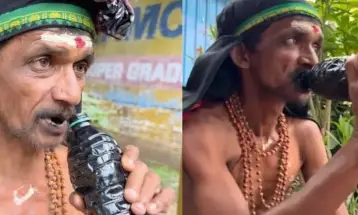Kawah Ijen Volcano: Java, Indonesia

Holiday Ayo - The Ijen volcano complex is a group of composite volcanoes located on the border between Banyuwangi Regency and Bondowoso Regency of East Java, Indonesia.
It is inside an eponymous larger caldera Ijen, which is about 20 kilometers (12 mi) wide. The Gunung Merapi stratovolcano is the highest point of that complex. The name "Gunung Merapi" means 'mountain of fire' in the Indonesian language; Mount Merapi in central Java and Marapi in Sumatra have the same etymology.
West of Gunung Merapi is the Ijen volcano, which has a one-kilometer-wide (0.62 mi) turquoise-colored acidic crater lake.
The lake is the site of a labor-intensive sulfur mining operation, in which sulfur-laden baskets are carried by hand from the crater floor.
The work is paid well considering the cost of living in the area but is very onerous. Workers earn around IDR 50,000– IDR 75,000 (USD 5.50 – USD 8.30) per day and once out of the crater, still need to carry their loads of sulfur chunks about three kilometers to the nearby Paltuding Valley to get paid.
Many other post-caldera cones and craters are located within the caldera or along its rim. The largest concentration of post-caldera cones runs east-west across the southern side of the caldera.
The active crater at Kawah Ijen has a diameter of 722 meters (2,369 ft) and a surface area of 0.41 square kilometers (0.16 sq mi).
It is 200 meters (660 ft) deep and has a volume of 36 cubic hectometres (29,000 acre-ft).
Since National Geographic mentioned the electric-blue flame of Ijen, tourist numbers have increased.
The phenomenon has occurred for a long time, but beforehand there was no midnight hiking. A two-hour hike is required to reach the rim of the crater, followed by a 45-minute hike down to the bank of the crater.
The blue fire ignited sulfuric gas, which emerged from cracks at temperatures up to 600 °C (1,112 °F).
The flames can be up to five meters (16 feet) high; some of the gas condenses to liquid and is still ignited.
It is the largest blue flame area in the world and local people refer to it as Api Biru (Blue Fire). The other location at which the blue fire can be seen is in Dallol mountain, Ethiopia.








Leave a comment